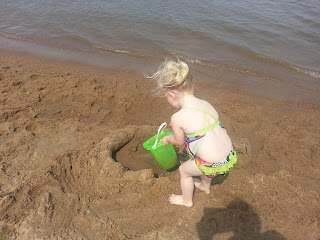The big thing this summer for Hg was/is Science Experiments! She often wants to do projects or experiments and I am 110% encouraging of this. As for the experiments- she's already been predisposed to baking soda & vinegar, cornstarch & water, diet soda & mentos as well as other benign experiments. She's also been privy to any number of explosions, dry ice fun, rocket launches, etc.
Best, easiest summer science experiment? H20! Make some ice, melt some ice. Add color, add fruit and eat it, add it to water and make it colder. It's sooo simple here are some ideas:
As I mentioned Hg loves experiments so I found a little folding table and put it outside as her work space. I put her chalk, buckets, finger paints etc. that she usually plays with in a container under it. I also included a large bucket for water and a deep pan for a reservoir to contain the experiments. I also made a science kit for her to get out on her own and play.
Science Kit contents:
Insta Snow power
Mixing Cup
Corn Starch
Small cups
Baking Soda
Food Coloring
Vinegar (in water bottle, clearly labled)
Measuring cups
Large cups
I marked a line on the mixing cup so Hg would know where to fill it for the Insta Snow but otherwise the mixtures for everything is somewhat open ended. The food coloring does get her messy so sometimes I nix it. We fill the metal bucket full of water so she can scoop it and wash her hands as needed.
Experiment 1.- Baking Soda and Vinegar:
Easy peasy. Put some baking soda in the pan, pour in some vinegar and see what happens. Pour the baking soda into some different shaped/height cups and see which one bubbles over the edge quickest.
For starters you can use separate containers of baking soda and vinegar, pre-measured. You can also add color and let it dry on paper to make art! Just watch where you pour this one when you're done, too much vinegar can hurt grass.
Experiment 2.- Non-Newtonian Fluid (cornstarch and water)
Mix Cornstarch and water. Add coloring if you like. Too liquidy? Add more cornstarch. Too solid? Add more water. The goo is solid when you put pressure on it but liquid when you don't!
Experiment 3.- Snow
You can buy Insta Snow powder online or at science/toy stores. The powder is sodium polyacrylate and you add water to it until it's the consistency you want. I marked a line so Hg would know the level of water to add to get fluffy snow but sometimes she adds more to get it more slushy. The stuff is cool to the touch and really fun to play with. The sodium polyacrylate is an additive to some garden chemical to keep soil moist so it is safe to throw out in the yard when you're done. (I have with no adverse effects).
These experiments your child can do on his/her own! They LOVE that independence. Just think to how much they love to help you cook and measure things out but that usually requires supervision and they can't always follow through because of safety concerns (ovens/stoves/etc.). This, they can do all by themselves!
Here are a few other science experiments we've done that did require some help from me:
Growing crystals
Making bathtub paint with ivory soap
Recipe here: http://www.housingaforest.com/fluffy-bathtub-paint/
Make a Lemon Battery













































wm_thumb%5B2%5D.jpg)







